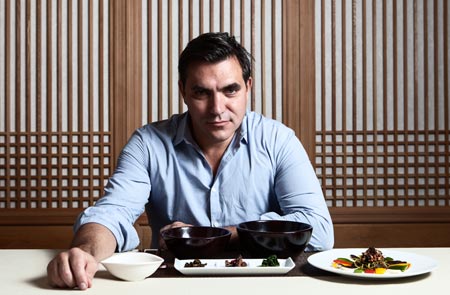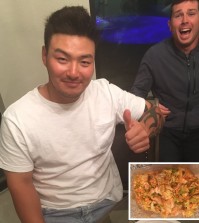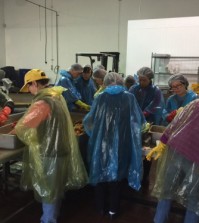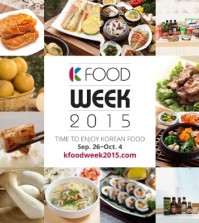- California Assembly OKs highest minimum wage in nation
- S. Korea unveils first graphic cigarette warnings
- US joins with South Korea, Japan in bid to deter North Korea
- LPGA golfer Chun In-gee finally back in action
- S. Korea won’t be top seed in final World Cup qualification round
- US men’s soccer misses 2nd straight Olympics
- US back on track in qualifying with 4-0 win over Guatemala
- High-intensity workout injuries spawn cottage industry
- CDC expands range of Zika mosquitoes into parts of Northeast
- Who knew? ‘The Walking Dead’ is helping families connect
‘Don’t be ethnic in K-food globalization’
Star chef Todd English sees high potential in temple food, citron tea
By Park Si-soo

Star chef Todd English poses at Gosang, a restaurant specializing in temple food, in Seoul on Sept. 4. / By freelance photographer Park Young-kyu
It was a seemingly well-organized operation with no chance of failure.
Under the code name “hansik (Korean food) globalization,” the government kick-started the project in 2008 with the big dream of lifting the country’s signature dishes to the same rank as hamburgers, sushi and pizza.
It spent nearly 80 billion won ($73.6 million) up to last year pushing forward with the ambitious project of opening a state-run upscale Korean restaurant in the heart of Manhattan, hanging promotional signs at tourism hot spots and hosting many events aimed at boosting awareness of Korean dishes globally.
Several Hollywood stars and high-profile figures were mobilized to facilitate the drive and, in the process, many regulatory barriers against it have been eliminated.
Five years on, the restaurant plan collapsed and, even worse, the whole project now faces the risk of losing its raison d’etre after being called a waste of its budget, for which a state audit has been underway for months.
There are pundits who recognize the positive impact of the project, but still the dominant view is that it was a money-losing operation.
Celebrity chef Todd English from New York City threw himself behind the negative standpoint, suggesting the government “not push” the globalization of Korean food.
“It was too ethnic. It wasn’t fun. People (American consumers) didn’t understand it,” English told The Korea Times in an interview at Gosang, an upscale restaurant specializing in temple food in downtown Seoul. “It was too serious. You got Americans the wrong way.”
The 53-year-old is an American millionaire with his own restaurant empire whose business territory spans across the United States. He earned rock-star status through his TV cooking show, “Food Trips with Todd English,” on America’s PBS TV channel.
He claimed Korean food has “huge” potential to become an international cuisine, adding the possibility will turn into reality only when it is blended with the mainstream culture of target markets.
“Korean food is becoming much more popular especially in cities like New York and L.A.,” English said. “But people still haven’t been exposed yet in the way that they should be. I think that the food is still misunderstood. What you need to do is make it (Korean food) part of the culture and make it cool… It has the appeal of what people consider as healthy and flavorful. So American barbeque has now become huge, now all over the world. Korean barbeque and Korean style cooking can certainly move in that direction.”
He said the strength of Korean food lies in its freshness and healthiness.
“When we think of sushi, we think light, fresh. People love it and Americans love it. So this could be put into the repertoire of eating if it is understood in a way that can be like Mexican or like Chinese noodles or ramen noodles. You can do the same thing with Korean food.”
But English said the two elements are not enough to make a hit in the U.S.
“You need to make food with your own twist,” he said, recollecting the memory of eating what he called the “best” Korean dishes in New York. “Just a little twist… I do things like take a red cabbage and do a quick kimchi. It’s not real kimchi but I can make red colored cabbage kimchi. And people love it… It’s a fresher version of it. I just think that it makes it trendy and hip and… has a good sensibility about it.”
He went on, “That to me is where I see or where the need to change is. Just a little bit. They are not that far off… The American consumer loves a challenge.”
He pointed out “kimchi tacos” as a model case of Korean food twisted in a way that meets American taste.
“It’s very simple, but it’s a huge sensation,” he said. “Give ideas on what to do with it… You can do great barbeques using simple Korean style marinades. And people will flip out over it. It’s delicious!”
The chef advised that taking the garlic smell out of Korean food is another importance.
“You need to find a way to deal with the common complaint over the smell,” he said. “People love Korean food but they think they smell like garlic. New Yorkers are very conscientious about what they wear. They don’t want to be smelling bad when they leave. It’s a very strong smell. So dial it down a little. Use technique.”
In this regard, English said, Korea’s temple foods gave him fresh ideas on how to upgrade his menu without worries about the smell.
“It’s still strange in the U.S. But I don’t think the Americans would react negatively to this,” he said after tasting vegetable-based temple foods. “They would think this is really delicious food. And vegetarianism is becoming really huge in the U.S. and elsewhere in the world and so I think this fits right in with all that.”
Other Korean foods he thinks would make appeal to U.S. consumers include citron tea and Korean-style stew boiled in clay pots.
“I think there is a way to present them in a slightly different package and the package is that it’s got a hipper, trendier vibe to it,” he said. “It’s great food to share and people love to share.”

















kim kardashian
October 6, 2013 at 10:33 PM
Greetings! I’ve been reading your site for a while now and finally
got the courage to go ahead and give you a shout out from Humble Texas!
Just wanted to tell you keep up the fantastic job!.